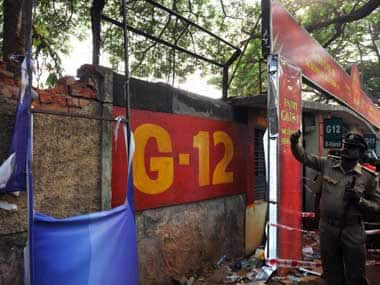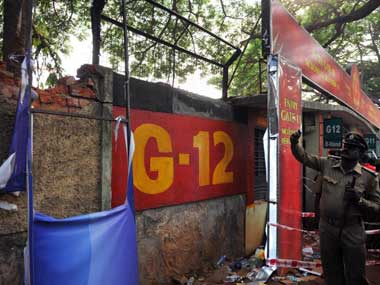[caption id=“attachment_1007539” align=“alignleft” width=“380”]
 Four people were hurt when two small bombs exploded near the Chinnaswamy Stadium in Bangalore on April 17, 2010. AFP[/caption] India’s National Investigations Agency has secured the arrest of key jihadist Abdul Sattar, linked to a cell that planned large-scale strikes across southern India, after a months-long hunt for the fugitive, highly placed government sources have told Firstpost. The NIA arrested Sattar in New Delhi late last week, after he was deported from a West Asian country on charges of violating his visa terms. He is scheduled to be produced before a Kerala anti-terrorism court today. Kerala’s anti-terrorism court is already conducting the trials of
30 men linked to the case
—several of also accused of having participated in multiple Indian Mujahideen bombings from 2005 to 2008, which claimed hundreds of lives. He will also be investigated, NIA sources say, for his possible role in multiple bomb attacks in Bangalore, including the 2010 strikes outside the Chinnaswamy cricket stadium. Students Islamic Movement of India ex-leader Safdar Nagori, the NIA alleges, provided firearms improvised explosive device fabrication training to Sattar and the other men at the three day camp at Vagamon, in Kerala’s Kottayam district. Investigators say their arrests disrupted a large south Indian jihad ring, led by Kerala jihadist Tadiyantavide Nasir. In early 2008, investigation records available with Firstpost claim, Nasir called Oman-based computer operator and fo Sarfaraz Nawaz with a request for funds for jihadist operations. [embedalsosee] Nawaz, investigators allege, turned to two Oman-based Lashkar-e-Taiba operatives, Abdul Aziz al-Hooti and Muhamma Rehan, to raise the cash from local Islamist leaders. That March, Nawaz is alleged to have met Nasir in Kerala, and discussed his plans to target Bangalore in bomb strikes. He also visited a small farmhouse at Madikere, near Coorg, which Nawaz had used to train jihad volunteers before they were sent on to camps in Pakistan or Jammu and Kashmir. Four Kerala men are known to have been
killed in a firefight
with Indian troops in the mountains above north Kashmir’s Kupwara. A fifth, Abdul Jabbar, escaped—but was later arrested, and is being tried. In March, the NIA had arrested another fugitive alleged to have been attended the training camp, Ranchi-based Manzar Imam. Imam is being investigated for his possible role in the twin bombings in Hyderabad’s Dilsukhnagar, which claimed 18. Last year, in June, the NIA had secured the extradition of 26/11 controller and one-time Maharashtra Zabiuddin Ansari, from
Saudi Arabia
. The arrest, brought about with assistance from the United States, marked a break in years of frustrating inability to secure the extradition of terror suspects who found safe havens in West Asia. Saudi Arabia
also deported
Fasih Mehmood, alleged to have been a close associate of Indian Mujahideen commander Riyaz Shahbandri. “This has come about in part because West Asian states realise that the Indian jihadists hiding out on their soil have connections to groups hostile to their own regimes, like al-Qaeda”, a senior diplomat said. “The United States has also played a very helpful role in facilitating our efforts”.
Four people were hurt when two small bombs exploded near the Chinnaswamy Stadium in Bangalore on April 17, 2010. AFP[/caption] India’s National Investigations Agency has secured the arrest of key jihadist Abdul Sattar, linked to a cell that planned large-scale strikes across southern India, after a months-long hunt for the fugitive, highly placed government sources have told Firstpost. The NIA arrested Sattar in New Delhi late last week, after he was deported from a West Asian country on charges of violating his visa terms. He is scheduled to be produced before a Kerala anti-terrorism court today. Kerala’s anti-terrorism court is already conducting the trials of
30 men linked to the case
—several of also accused of having participated in multiple Indian Mujahideen bombings from 2005 to 2008, which claimed hundreds of lives. He will also be investigated, NIA sources say, for his possible role in multiple bomb attacks in Bangalore, including the 2010 strikes outside the Chinnaswamy cricket stadium. Students Islamic Movement of India ex-leader Safdar Nagori, the NIA alleges, provided firearms improvised explosive device fabrication training to Sattar and the other men at the three day camp at Vagamon, in Kerala’s Kottayam district. Investigators say their arrests disrupted a large south Indian jihad ring, led by Kerala jihadist Tadiyantavide Nasir. In early 2008, investigation records available with Firstpost claim, Nasir called Oman-based computer operator and fo Sarfaraz Nawaz with a request for funds for jihadist operations. [embedalsosee] Nawaz, investigators allege, turned to two Oman-based Lashkar-e-Taiba operatives, Abdul Aziz al-Hooti and Muhamma Rehan, to raise the cash from local Islamist leaders. That March, Nawaz is alleged to have met Nasir in Kerala, and discussed his plans to target Bangalore in bomb strikes. He also visited a small farmhouse at Madikere, near Coorg, which Nawaz had used to train jihad volunteers before they were sent on to camps in Pakistan or Jammu and Kashmir. Four Kerala men are known to have been
killed in a firefight
with Indian troops in the mountains above north Kashmir’s Kupwara. A fifth, Abdul Jabbar, escaped—but was later arrested, and is being tried. In March, the NIA had arrested another fugitive alleged to have been attended the training camp, Ranchi-based Manzar Imam. Imam is being investigated for his possible role in the twin bombings in Hyderabad’s Dilsukhnagar, which claimed 18. Last year, in June, the NIA had secured the extradition of 26/11 controller and one-time Maharashtra Zabiuddin Ansari, from
Saudi Arabia
. The arrest, brought about with assistance from the United States, marked a break in years of frustrating inability to secure the extradition of terror suspects who found safe havens in West Asia. Saudi Arabia
also deported
Fasih Mehmood, alleged to have been a close associate of Indian Mujahideen commander Riyaz Shahbandri. “This has come about in part because West Asian states realise that the Indian jihadists hiding out on their soil have connections to groups hostile to their own regimes, like al-Qaeda”, a senior diplomat said. “The United States has also played a very helpful role in facilitating our efforts”.
NIA arrests fugitive Kerala jihadist allegedly involved in blasts since 2005
Praveen Swami
• August 3, 2013, 13:25:53 IST
Kerala resident Abdul Sattar is alleged to have trained with a SIMI-linked cell, but had escaped to a West Asian country from where he has now been deported
Advertisement
)
End of Article